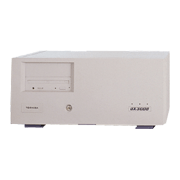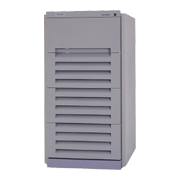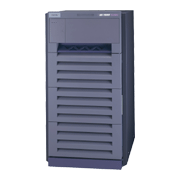The UX5000 was the first model of the UX UNIX server series announced by Toshiba in February 1993. Toshiba marketed the UX5000 using OEM models of Sun Microsystems’ SPARCcenter 2000. The UX series grew with the addition of the UX3000 (SPARCserver 1000) in May 1993 and the UX7000 series (Ultra Enterprise series) in April 1996. These models were all OEM.
The UX5000 housed up to 10 system boards, each having two SuperSPARC processors (40 MHz), for a maximum of 20 CPUs. The maximum configuration ran at 2,190 MIPS or 268 megaFLOPs.
The UX3000 housed up to four system boards, each having two SuperSPARC processors (50 MHz), for a maximum of eight CPUs. The maximum configuration ran at 1,000 MIPS or 130 megaFLOPs.
The UX7000 series consisted of five models: E/150, E/3000, E/4000, E/5000, and E/6000. These corresponded, respectively, to Sun Microsystems’ Ultra Enterprise 150, 3000, 4000, 5000, and 6000 models. The UX7000 models ran on the UltraSPARC-I (167 MHz) processor, which had a 64-bit architecture.
| Series | UX3000 | UX5000 | UX7000 | |||||
|---|---|---|---|---|---|---|---|---|
| Model | E/ 6000 | E/ 5000 | E/ 4000 | E/ 3000 | E/ 150 | |||
| Introduced | May 1993 | February 1993 | April 1996 | |||||
| CPU | Super SPARC (50MHz) |
Super SPARC (40MHz) |
64-bit UltraSPARC-I (167 MHz) | |||||
| Max. number of CPUs | 8 | 20 | 30 | 14 | 14 | 6 | 1 | |
| Max. memory capacity | 2GB | 5GB | 30GB | 14GB | 14GB | 6GB | 1GB | |
| Max. disk capacity | 100GB | 491GB | 10TB | 6TB | 4TB | 2TB | 144GB | |
| Network interface | 10BASE-T | 10BASE-T | 10BASE-T/100BASE-TX | |||||
| Performance (SPEC rate) |
int2 | 2,730 (2CPU) 10,113 (8CPU) |
2,326 (2CPU) 8,047 (8CPU) |
|||||
| fp92 | 3,681 (2CPU) 12,710 (8CPU) |
2,953 (2CPU) 10,600 (8CPU) |
||||||
| Extra reliability features |
|
|
||||||




